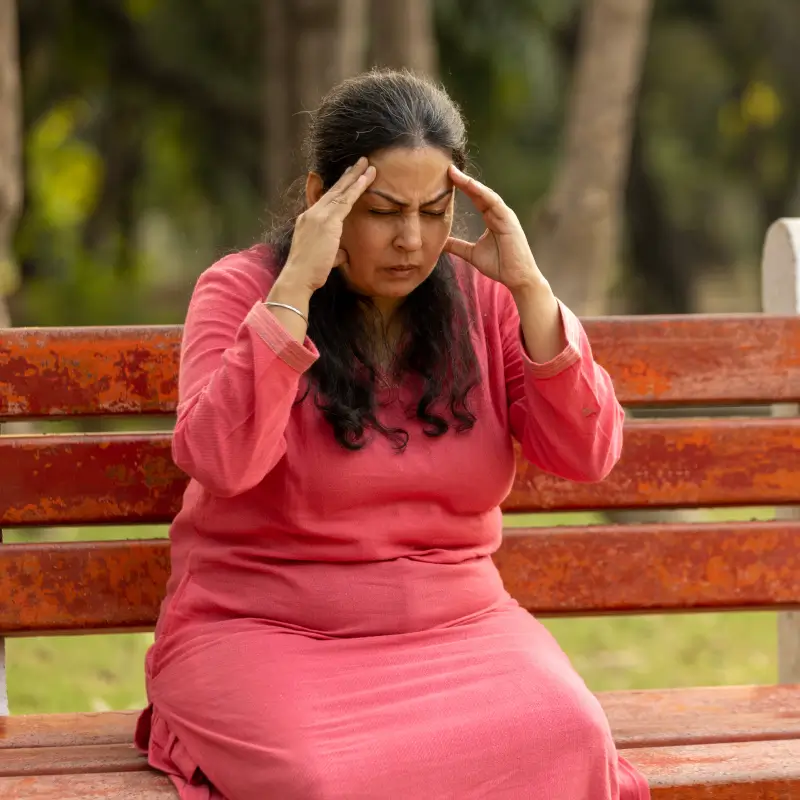Home/Wellness Zone/Sakra Blogs
21st Oct, 2025

Stroke is a leading cause of disability and death worldwide, and it affects women differently than men. Women not only experience strokes more frequently at older ages, but they are also more likely to have severe outcomes. Understanding the causes of a stroke in women, recognizing stroke symptoms in women, and knowing the pre-stroke symptoms in females can save lives. Early detection and intervention are crucial.
A stroke occurs when the blood supply to the brain is interrupted or reduced, preventing brain tissue from receiving enough oxygen and nutrients. Brain cells begin to die within minutes, leading to possible long-term disability or death. Strokes are generally classified into two types:
Ischemic Stroke: Caused by a blood clot blocking a blood vessel in the brain.
Hemorrhagic Stroke: Caused by a blood vessel rupturing and bleeding into or around the brain.
While the causes of stroke in men and women share some similarities, certain factors make women more vulnerable:
High Blood Pressure (Hypertension): The leading cause of stroke in women. Uncontrolled blood pressure damages blood vessels, increasing stroke risk.
Heart Disease: Conditions such as atrial fibrillation, heart valve disease, or congestive heart failure increase the likelihood of blood clots traveling to the brain.
Diabetes: High blood sugar can damage blood vessels and accelerate atherosclerosis (hardening of the arteries).
Obesity: Excess weight increases the risk of high blood pressure, diabetes, and high cholesterol.
Hormonal Factors: Pregnancy, menopause, and the use of oral contraceptives or hormone replacement therapy can influence stroke risk.
Obstructive sleep apnea (snoring disease)
Smoking and Alcohol Use: Both contribute to arterial damage and clot formation.
Family History: Genetics can play a significant role, especially if stroke or heart disease runs in the family.
Migraines with Aura: Women who experience migraines with visual or sensory disturbances are at higher risk of stroke.
Certain conditions and life stages put women at higher risk for strokes:
Pregnancy-Related Risks: Pregnancy-induced hypertension (preeclampsia), gestational diabetes, or blood clots during pregnancy can trigger a stroke.
Menopause: The natural decline of estrogen during menopause affects blood vessel health, increasing stroke susceptibility.
Hormone Therapy: Postmenopausal hormone replacement therapy and some birth control pills may elevate stroke risk, particularly in smokers or women with other risk factors.
Recognizing stroke symptoms in women is vital because early treatment can reduce the severity and improve recovery. While some symptoms are classic, women often experience subtle or unusual signs:
Sudden Weakness or Numbness: Typically on one side of the body, affecting the face, arm, or leg.
Confusion or Trouble Speaking: Difficulty understanding speech, slurred words, or sudden inability to communicate.
Vision Problems: Blurred vision, double vision, or loss of vision in one eye.
Severe Headache: Sudden, intense headache without a clear cause.
Dizziness or Loss of Balance: Unexplained unsteadiness or trouble walking.
Fatigue or Fainting: Unusual tiredness, sudden weakness, or fainting can be a warning.
Nausea and Vomiting: These may accompany other neurological symptoms.
Pre-stroke symptoms in females, often called transient ischemic attacks (TIAs), are temporary and may resolve within minutes or hours, but they are a serious warning. Don’t ignore:
Sudden transient weakness or numbness or tingling
Brief vision changes
Short episodes of speech difficulty
Mild dizziness or imbalance
Women can lower their risk of stroke by managing lifestyle and health factors:
Monitor Blood Pressure: Keep it within the normal range through diet, exercise, and medication if needed.
Maintain Healthy Cholesterol Levels: A balanced diet and regular check-ups help prevent artery blockages.
Control Blood Sugar: Proper management of diabetes is crucial for stroke prevention.
Exercise Regularly: Aim for at least 30 minutes of moderate activity most days.
Avoid Smoking and Limit Alcohol: Both are significant contributors to stroke risk.
Maintain a Healthy Weight: Reducing obesity lowers the risk of high blood pressure and diabetes.
Stay Alert to Warning Signs: Don’t ignore TIAs or unusual neurological symptoms; early treatment saves lives.
Discuss Hormone Therapy: Consult your doctor about the risks of birth control pills or hormone replacement therapy.
Correction of sleep apnea, any heart condition like Atrial fibrillation if it exists
Strokes in women can be silent, subtle, or different from classic male stroke symptoms. Knowing the causes of a stroke in a woman, being aware of stroke symptoms in women, and recognizing pre-stroke signs can make all the difference. Early detection, medical intervention, and preventive lifestyle measures are key to reducing the risk of serious brain injury.
If you notice any sudden neurological changes in yourself or others, seek medical attention immediately. Acting fast can prevent long-term disability and save lives.
Q1. Are women more likely to die from strokes than men?
Yes. Women tend to have strokes at older ages and may experience more severe outcomes compared to men.
Q2. What are pre-stroke symptoms in females?
Transient symptoms like temporary numbness, dizziness, vision problems, or slurred speech are warning signs of a possible upcoming stroke.
Q3. Can lifestyle changes reduce stroke risk in women?
Absolutely. A healthy diet, regular exercise, controlling blood pressure, cholesterol, and diabetes, along with quitting smoking, significantly lowers stroke risk.
Q4. When should I see a doctor?
Any sudden weakness, numbness, confusion, vision problems, or severe headache should prompt immediate medical evaluation.
Q5. How does pregnancy affect stroke risk?
Pregnancy can increase stroke risk due to conditions like preeclampsia, gestational diabetes, and blood clots. Monitoring and preventive care are important
Enquire Now
